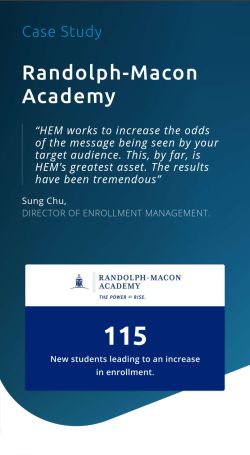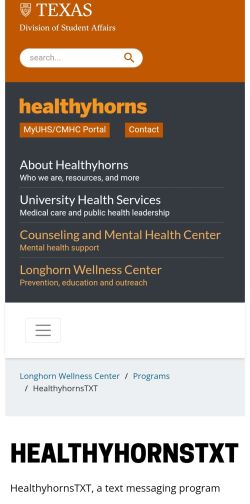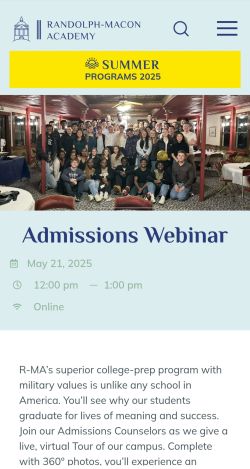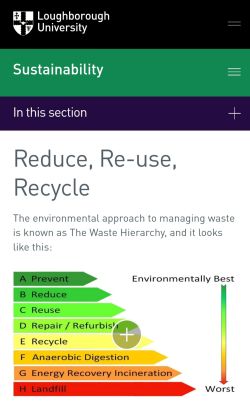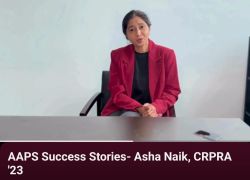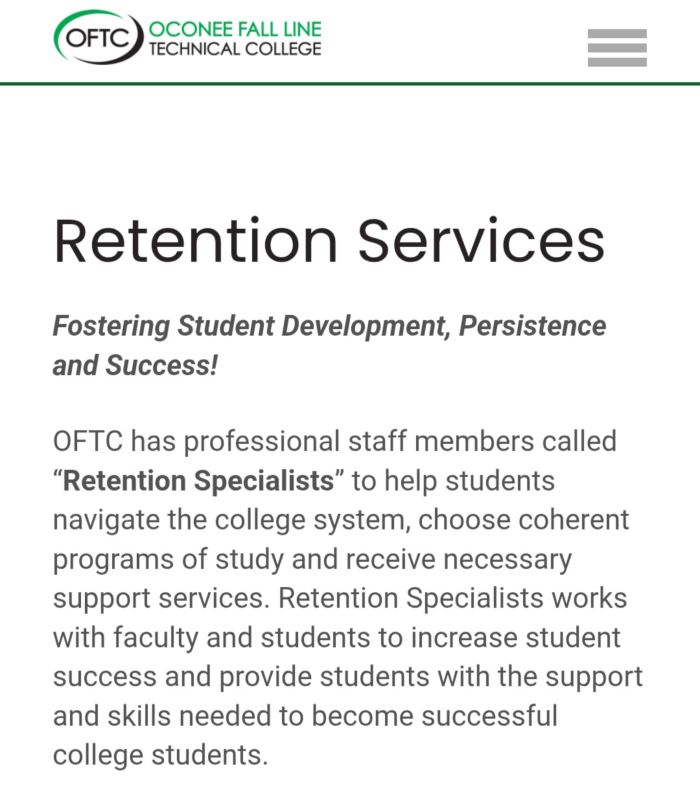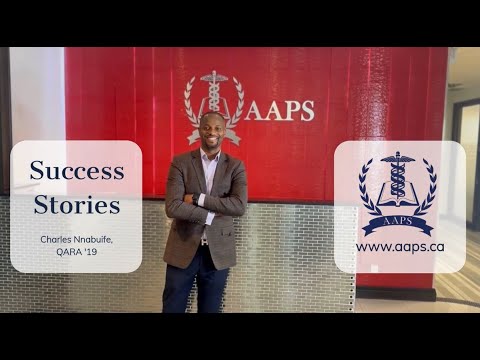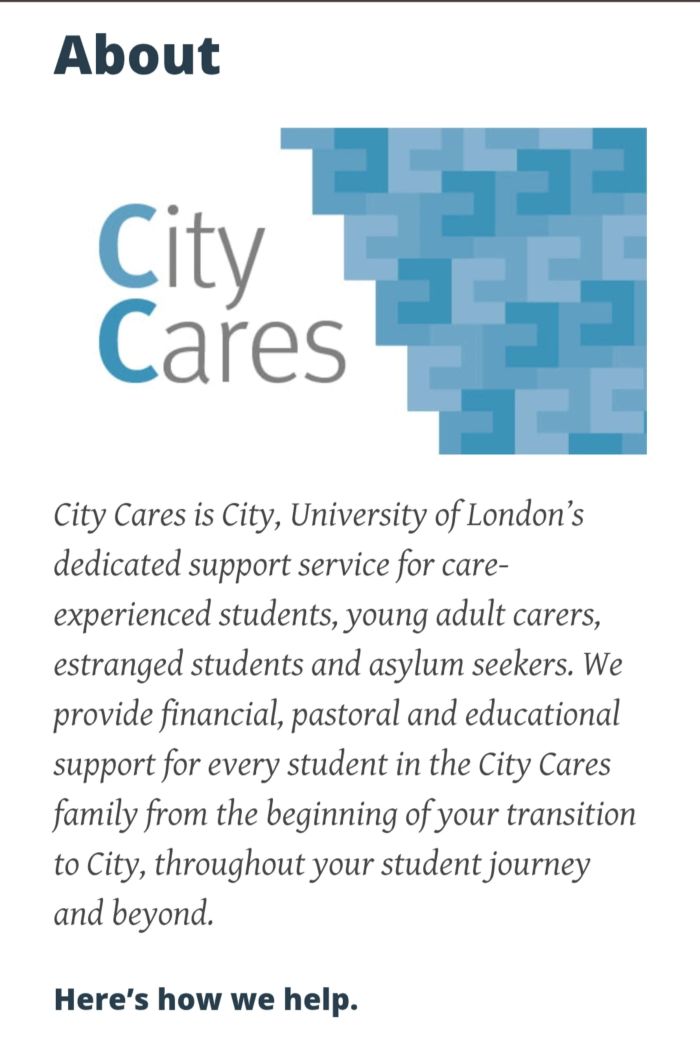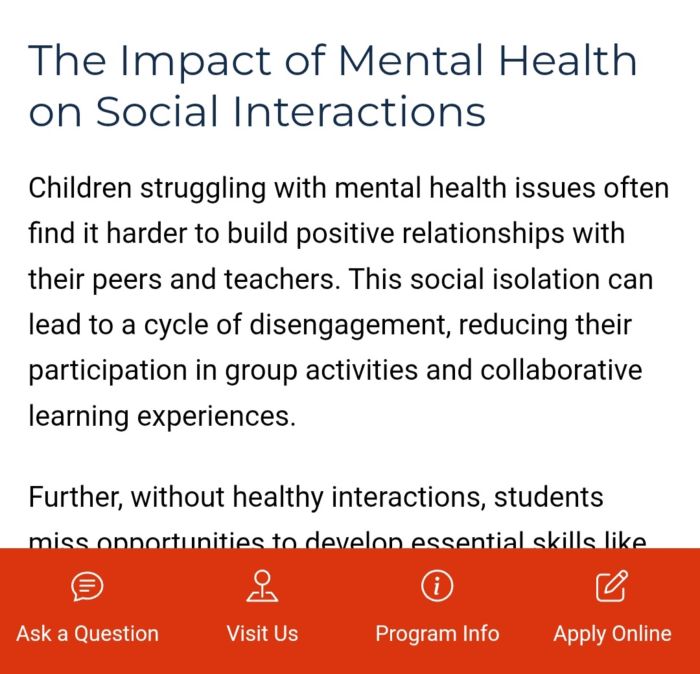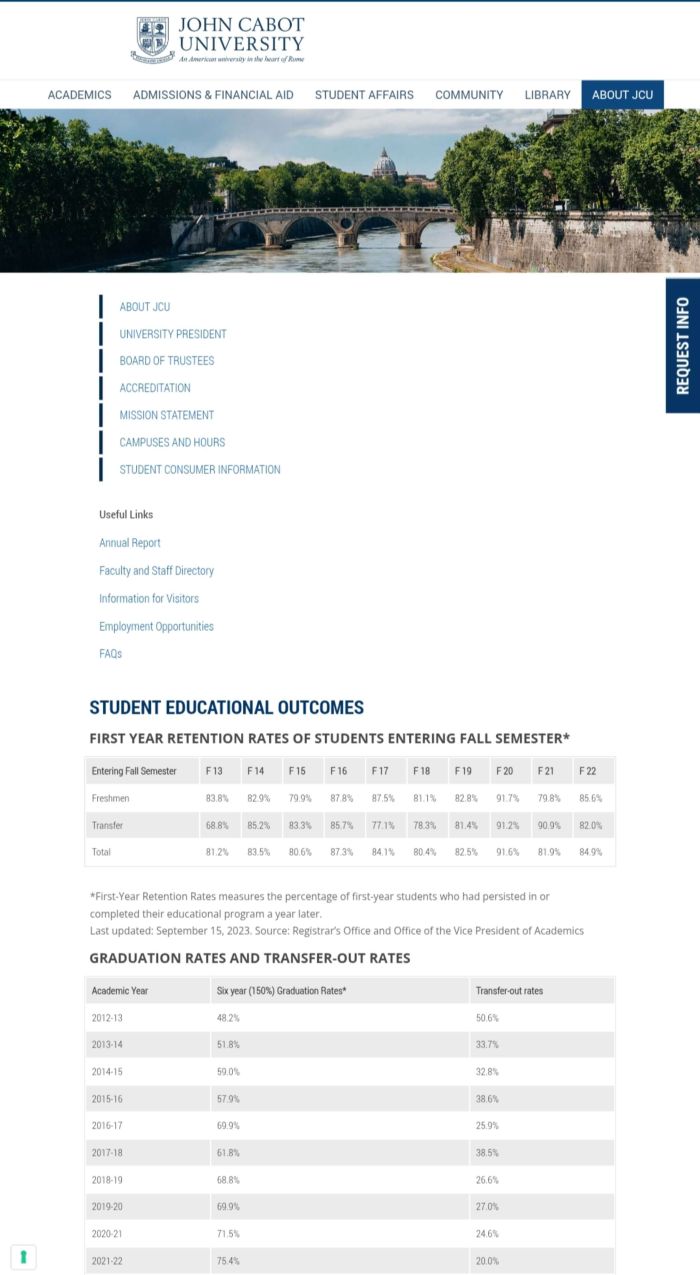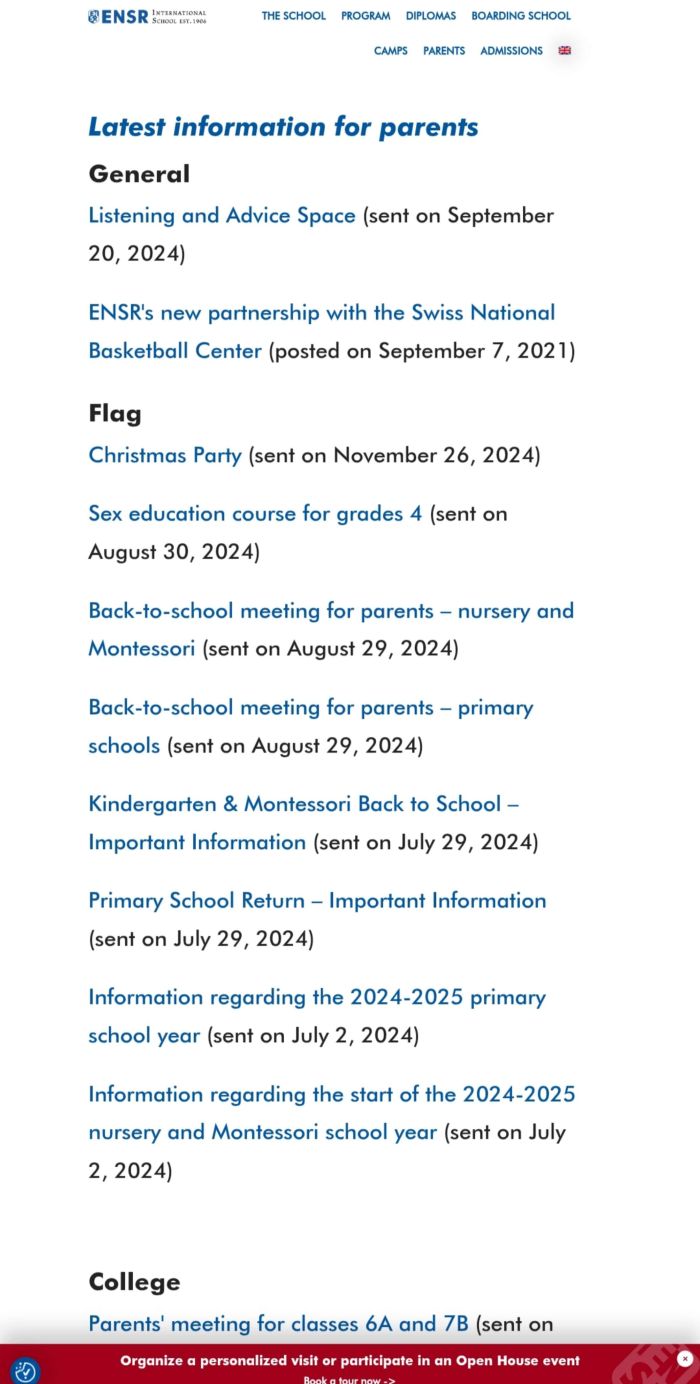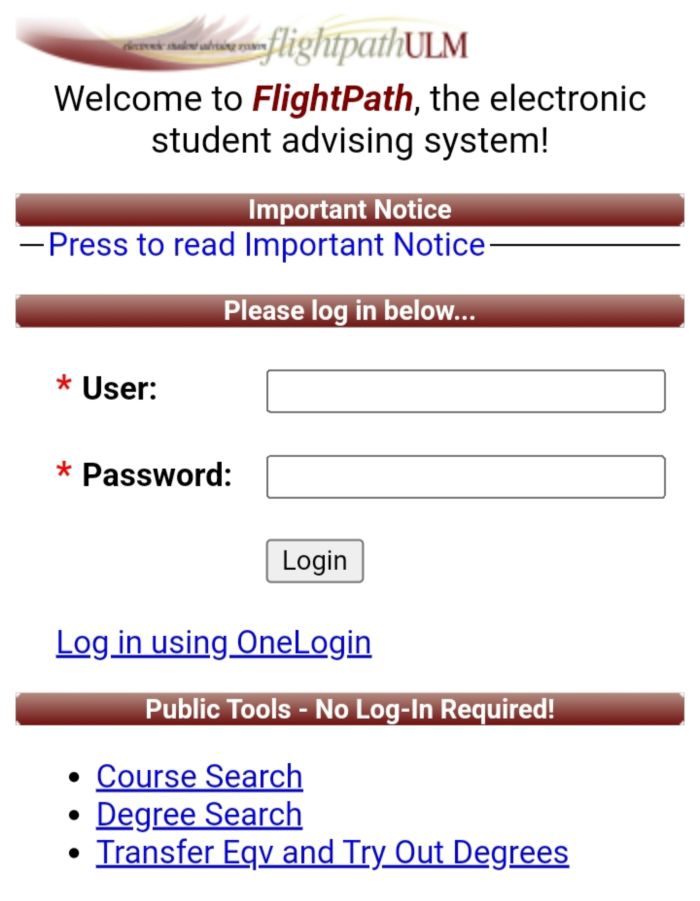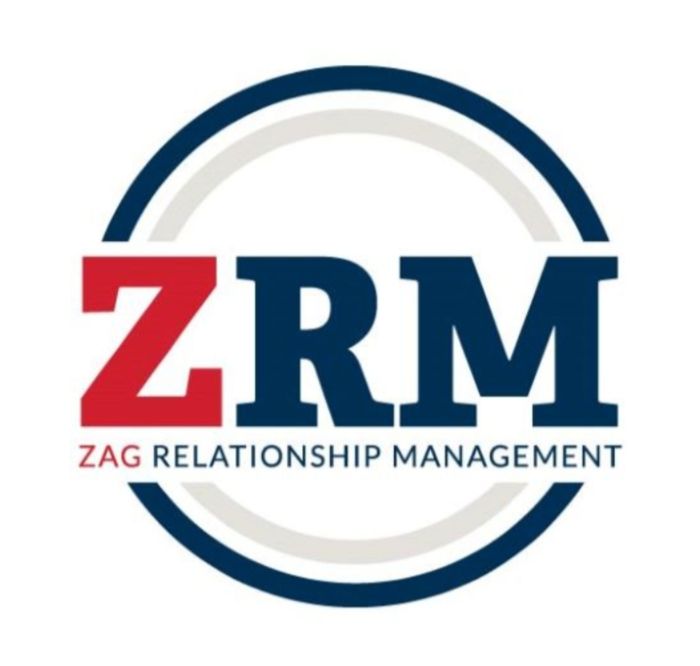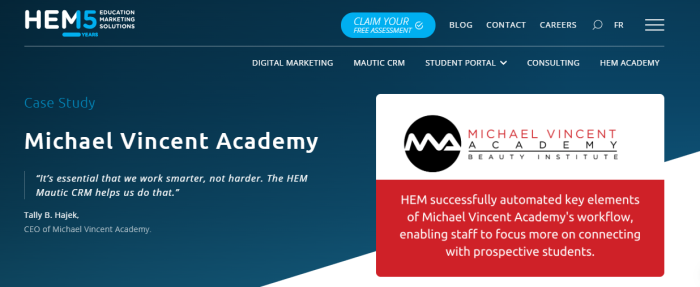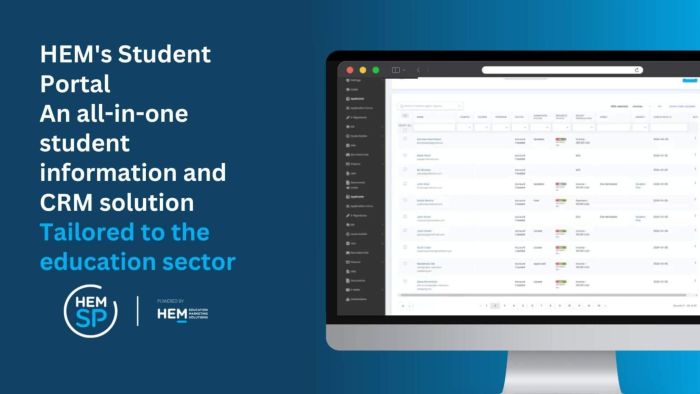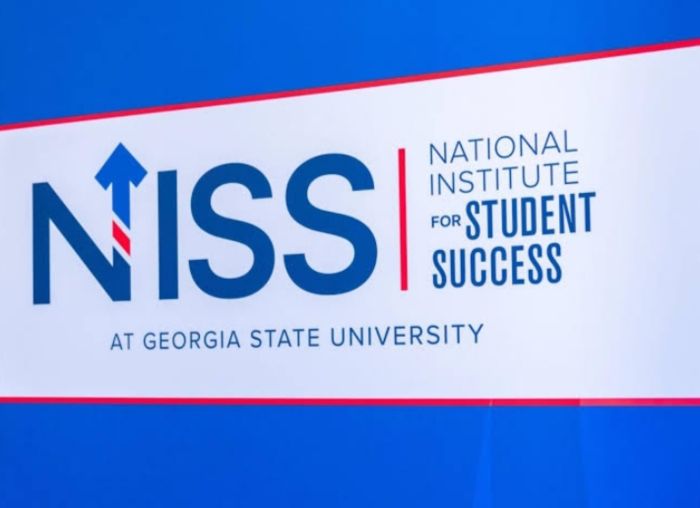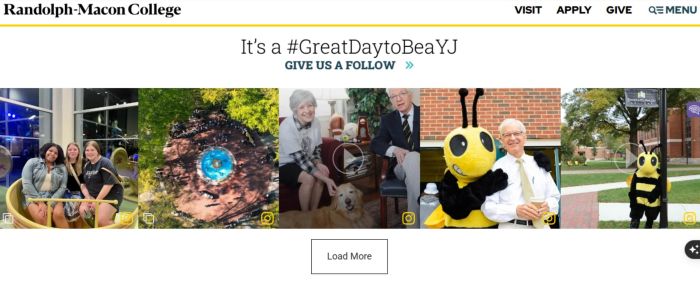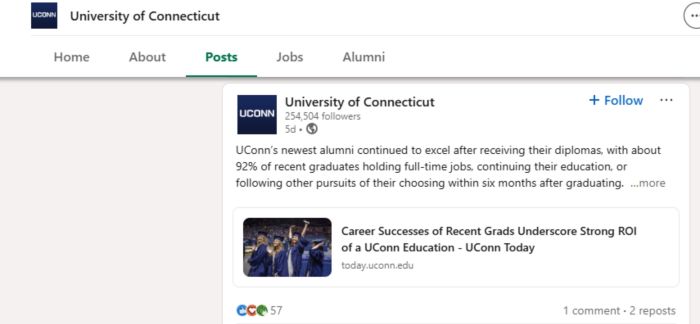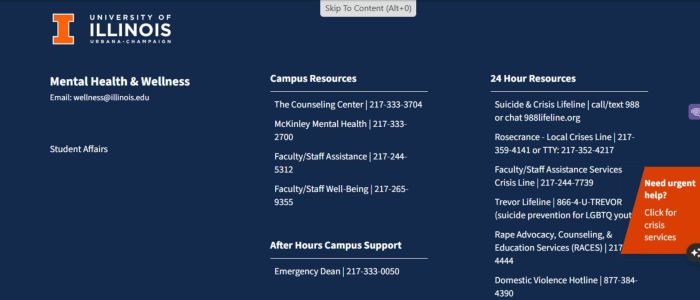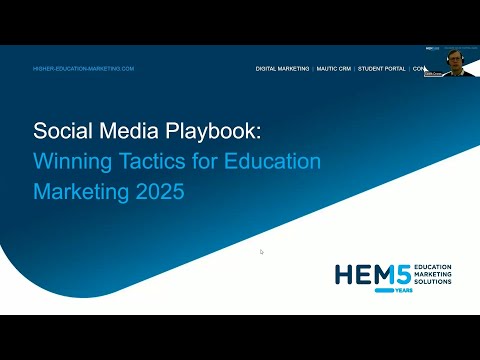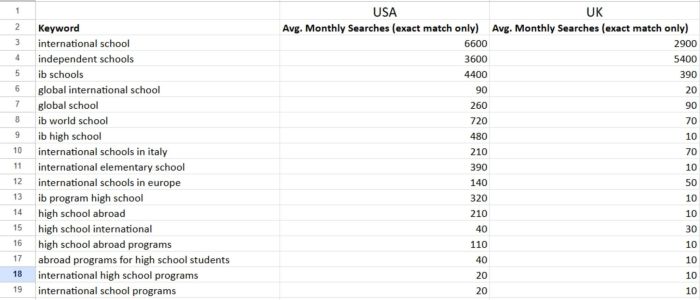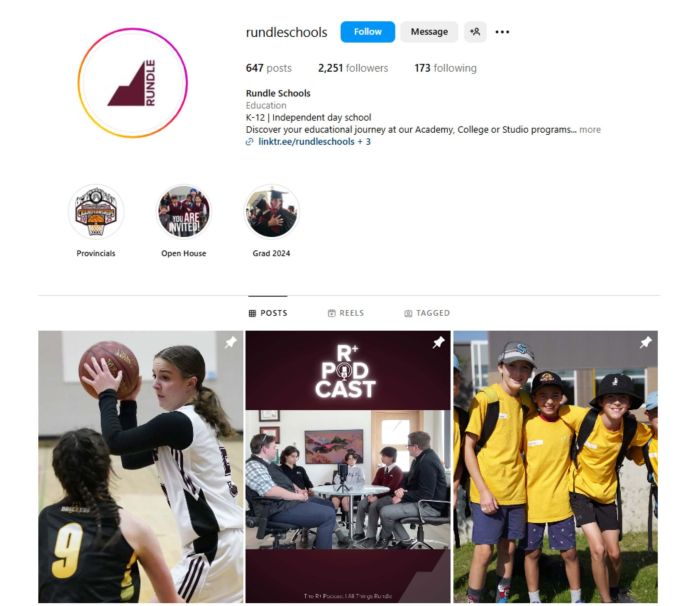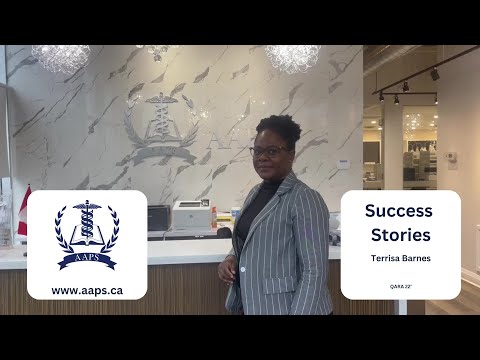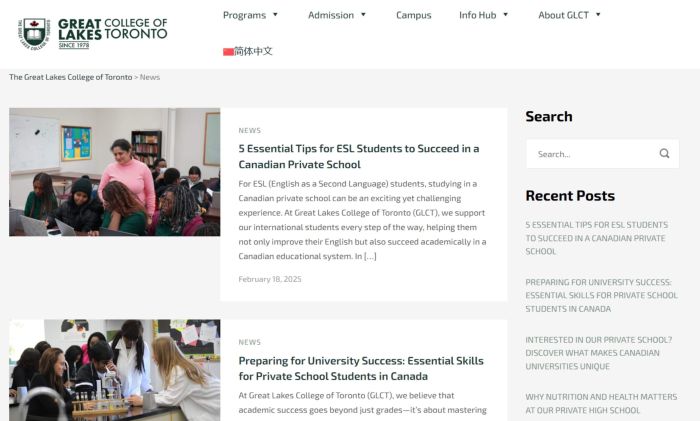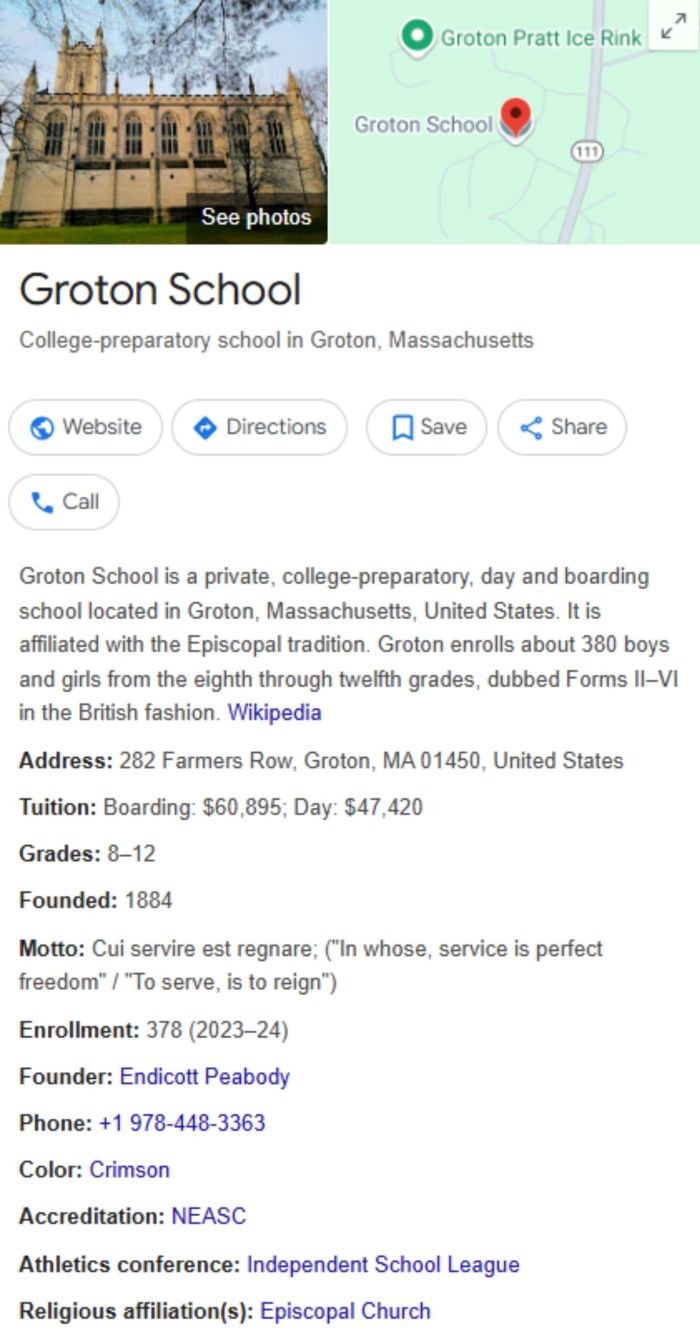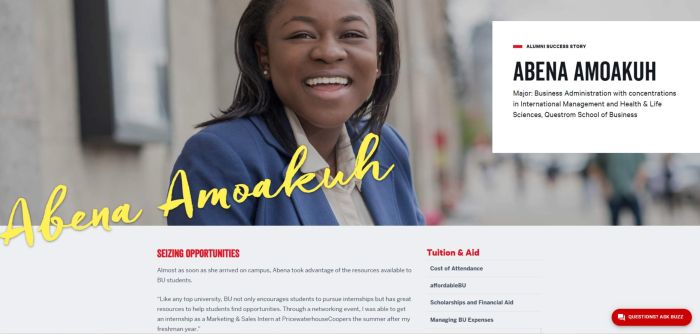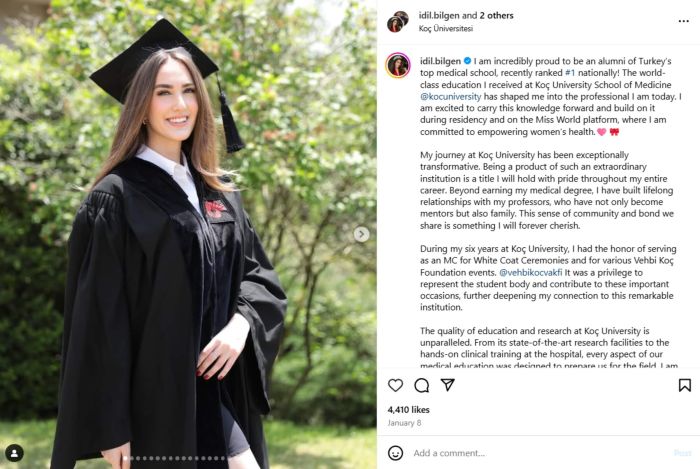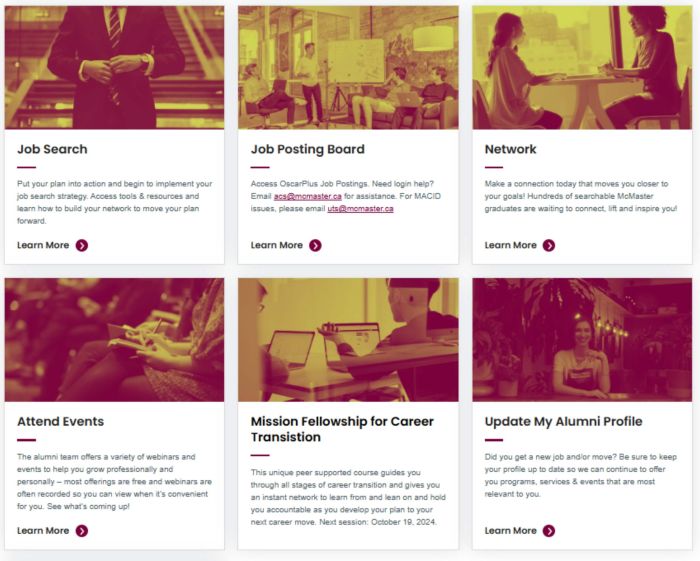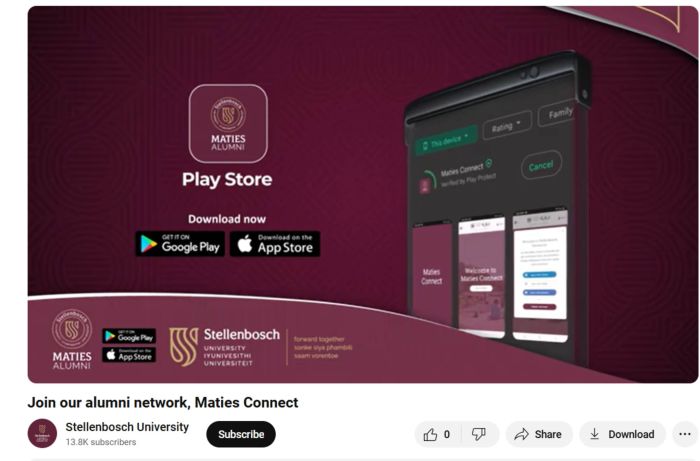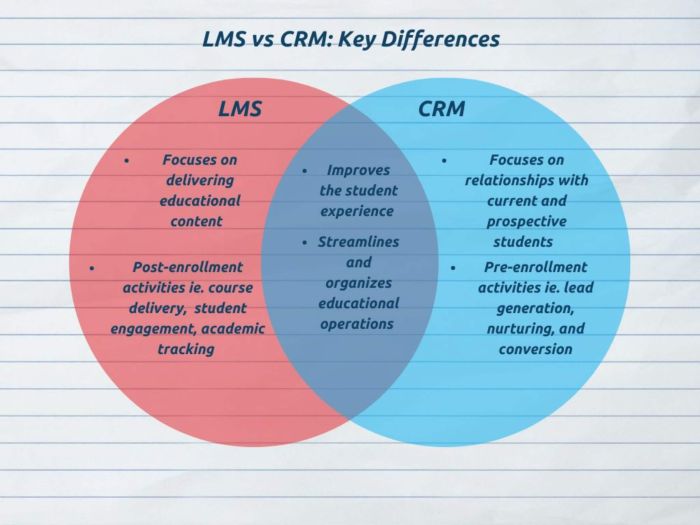In a world obsessed with TikTok trends and digital ad spends, it’s easy to overlook the humble email. Yet, email marketing for universities and other higher educational institutions isn’t just surviving, it’s thriving.
While newer platforms grab headlines, email continues to deliver results where it matters most: student recruitment. In fact, email engagement has surged by a staggering 78% in recent years. That’s a clear signal: email is not just relevant, it’s essential.
Email remains one of the most powerful channels in higher education marketing, and for good reason. By the end of 2025, global email users are projected to reach 4.6 billion, with over 376 billion emails sent daily.
The ROI speaks for itself: email marketing returns around $36 for every $1 spent, outshining many other channels. Here’s the surprising part. Students want your emails. In a recent survey, more than 68% of students prefer to receive content via email from higher-ed institutions.
But many schools are still doing it wrong. They send the same message to every contact, ignore personalization, and fail to align emails with the student journey. The result? Missed opportunities and low conversions.
This guide will walk you through how to craft student-first, high-converting email campaigns, from audience research to measuring real impact. Ready to turn your inbox into an enrollment engine? Let’s dive in.
Why Email? Why Now?
Let’s start from the very beginning. What is educational marketing? Educational marketing refers to the strategies and tactics used by schools, colleges, and universities to attract, engage, and enroll students. It includes campaigns across digital channels like email, social media, SEO, and paid ads to promote programs and build institutional brand awareness.
From there, we move on to the big question: Is email still relevant in 2025? Absolutely. In fact, 69% of education marketers say email provides a good to excellent ROI, outperforming heavy hitters like social media (55%), display ads (19%), and even SEO (46%).
Why is that?
Because email does three things exceptionally well. It provides a direct line to decision-makers, allows for scalable personalization, and supports long-term engagement without burning through your budget.
But, and this is key, many schools still aren’t tapping into its full potential. Too often, the same message is sent to everyone, without clearly defined audience profiles to guide the way. That’s where opportunity lives, for those willing to do it right.
Know Your Audience: Meet Sophie
Let’s talk about what separates forgettable campaigns from unforgettable ones.
It starts with understanding your audience, not just broadly, but deeply. This is where student personas come into play.
Meet Sophie.
She’s a 30-something international career professional with 3–7 years of experience. Sophie is exploring MBA programs and micro-credentials, driven by career advancement and global networking opportunities. She’s ROI-conscious, skeptical about short courses, and likely found your school via Instagram or Google.
See the difference?
When you write with Sophie in mind, you’re not just blasting content, you’re building trust. She wants to know your credentials are legit. She’s inspired by student success stories. She’s curious about cultural experiences.
So instead of saying, “Join our business program,” try, “Boost your global career with accredited micro-credentials and a community that spans five continents.” Now that’s an email that connects. Now that we’ve seen what a well-developed persona looks like, let’s explore how to apply this kind of insight through segmentation.
Example: McMaster University’s Continuing Education division’s persona-based email drip campaigns for lead nurturing show how each email is tailored to a persona (e.g. career changers in Project Management or Applied Clinical Research) with personalized greetings (“Hi {{FirstName}}”) and program-specific content.
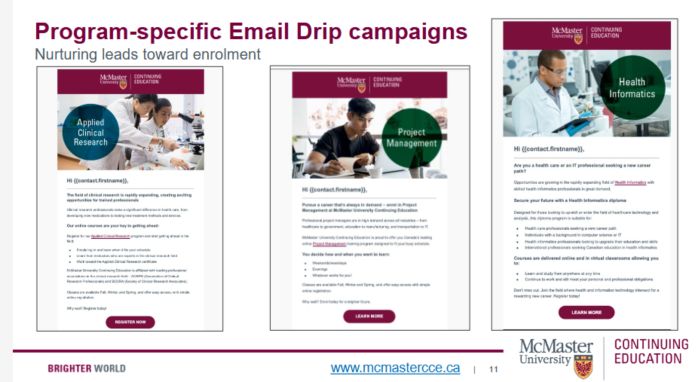

Source: McMaster University
Make It Personal: Segmentation and Customization
Different students have different interests and needs, so your university email campaign should too.
Segmentation
By dividing your email list into meaningful groups (or “segments”), you can send each group content that truly matters to them. The result? Dramatically better performance.
For instance, marketers have seen a staggering 760% increase in email revenue from segmented campaigns. Campaign Monitor also found that segmented education campaigns can achieve open rates around 18%, far above the industry average. Clearly, segmentation isn’t just a nice-to-have; it’s a game-changer.
How to segment effectively? Think about the factors that distinguish your prospective students. Common segmentation angles in higher ed include:
- Stage in enrollment journey: Are they brand-new inquiries, applicants, or admitted students? (More on this later.)
- Academic interests: What program or major are they interested in? Emails tailored by program (e.g. Engineering vs. Liberal Arts prospects) will highlight different selling points.
- Demographics/Location: Is the student international or domestic? High school senior or adult learner? Local or out-of-state? Each group may respond to different messaging.
- Behavioural engagement: How have they interacted with your school so far? (Attended a webinar, downloaded a brochure, etc.) Those actions can trigger targeted follow-ups.
Segmenting your list by criteria like these ensures each student gets content that speaks to their specific situation. As a result, your emails feel more relevant, and relevance drives results.
Example: The Cut Design Academy launched a promotional recruitment email targeting prospective students for its January 2025 Makeup Artistry Certificate intake. The campaign focused on driving immediate applications from students close to the decision stage, offering a limited-time tuition discount to accelerate conversions. Framed around an exclusive offer, the email used urgency, clear benefits, and student-focused messaging to stand out. The campaign leveraged personalization through tone (“Dear creative mind”) and clear calls to action, guiding prospects from interest to enrollment with stage-aligned messaging.
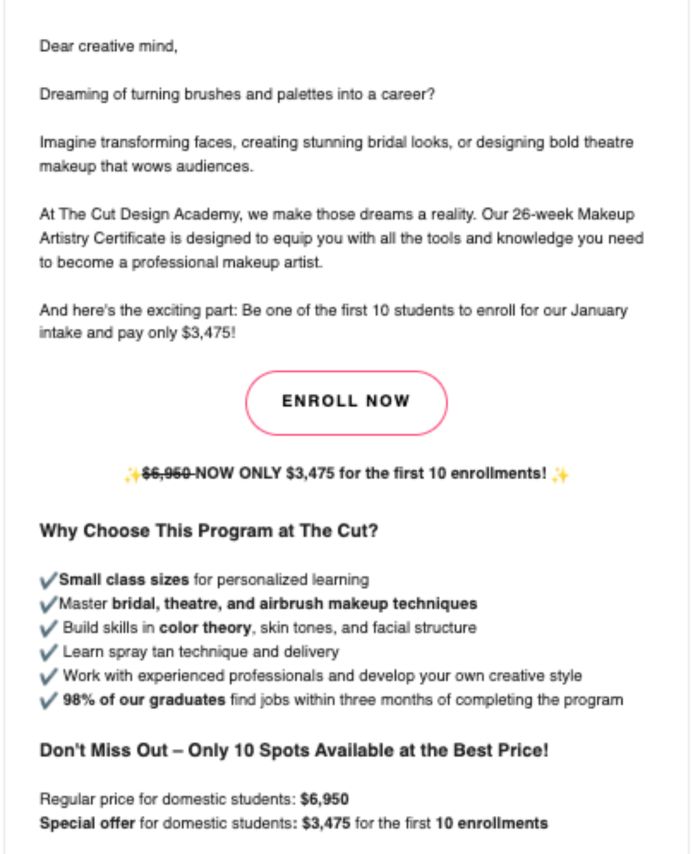

Source: The Cut Design Academy
Segmented emails consistently outperform generic blasts, leading to stronger engagement, greater relevance, and improved results across the board. Marketers find that tailoring messages to specific audience groups makes campaigns more effective and impactful. The bottom line? When you embrace the diversity of your audience and tailor your messaging accordingly, they’ll reward you with higher engagement.
Let’s say you have a student interested in your Executive MBA. They’ve clicked on emails but haven’t registered for an event. You wouldn’t send them the same message as a high school student in Colombia interested in ESL.
Personalization
Now add personalization on top. If segmentation is about who you’re writing to, personalization is about what and how you communicate to each person. Today’s prospective students expect a personalized touch, and they respond when they get it.
Here’s why: Research shows that emails with personalized content have a 29% higher open rate and a 41% higher click-through rate than non-personalized emails. Simply put, personalization grabs attention. It signals to the student that “this is about you,” cutting through the clutter of impersonal mass communications.
Personalization can be as simple as using the student’s first name in the greeting or subject line – emails with a personalized subject are 29% more likely to be opened, according to Experian. But it goes much deeper than that. Effective enrollment emails often incorporate personal details like the student’s intended major, specific interests, or past interactions.
Let’s Look At Two Examples:
- If a prospect has shown interest in your business program, your follow-up emails should reflect that. Highlight business-specific content such as alumni success stories, internship opportunities, and upcoming events related to the program. This reinforces relevance and keeps the student engaged with information they care about.
- If a student clicks on a link about financial aid, your next email could focus on scholarships, bursaries, or affordability tips. This kind of targeted follow-up shows that you’re paying attention to their concerns. And students notice this effort.
An EAB survey in 2024 found that 93% of students said receiving a personalized message from a college would encourage them to explore that school further.
That’s an overwhelming majority who are more likely to engage simply because your email spoke directly to their interests or concerns. 71% of students expect personalized interactions from brands (including universities), and 76% get frustrated when they don’t get them. The message is clear: personalization isn’t just a nice touch; it’s expected.
Example: This email from London Business School (LBS), addressed personally to the recipient (“Conor, come and meet some of the people that make LBS unique”), exemplifies effective personalization (using the student’s name and regional relevance) and event-based drip sequencing, reinforcing LBS’s presence and availability as the student prepares to make a decision.


Source: London Business School
So, how can you infuse personalization into your campaigns? Here are a few proven tactics (think of these as the “little things” that yield big results):
- Use dynamic fields: Most email platforms allow you to insert the recipient’s name or other attributes automatically. A subject like “John, here’s info on the Computer Science program you liked” is far more engaging than a generic “Learn about our programs.”
- Tailor content to personas: If you’ve segmented by persona or interest, craft the email copy and images to match each segment. A student athlete might get an email highlighting campus sports facilities and team success, whereas a fine arts prospect might see content about your art studios or student exhibits.
- Leverage behavioural data: Personalization can also be triggered by what a student does. For instance, “We noticed you started an application – here are the next steps,” or “Thanks for downloading our Nursing Program guide – would you like to attend a nursing info session?” These timely, relevant messages show that you’re paying attention and ready to help.
In a nutshell, how do you develop a marketing strategy for a university? Start by defining clear goals (e.g., increase applications or improve yield), identify target audiences using personas, choose the right channels (email, social, SEO), create tailored content for each stage of the student journey, and measure results regularly to optimize performance.
Align With the Student Journey
A student’s path from curiosity to commitment isn’t linear. Your email marketing strategy shouldn’t be either.
Awareness
This is your digital handshake. Send welcome emails that reflect your institution’s voice: professional, warm, and resourceful. Keep it brief and include CTAs to helpful blog posts, reports, or program videos. The goal here? Spark interest and build trust.
Example: Algonquin College initiated a welcome email campaign targeting newly inquiring students, aimed at supporting the awareness stage of the enrollment funnel. This automated email is sent immediately after a student checks out a program or completes an inquiry form, making it a textbook example of an early-stage drip campaign designed to keep the college top-of-mind and help prospects begin their research journey.
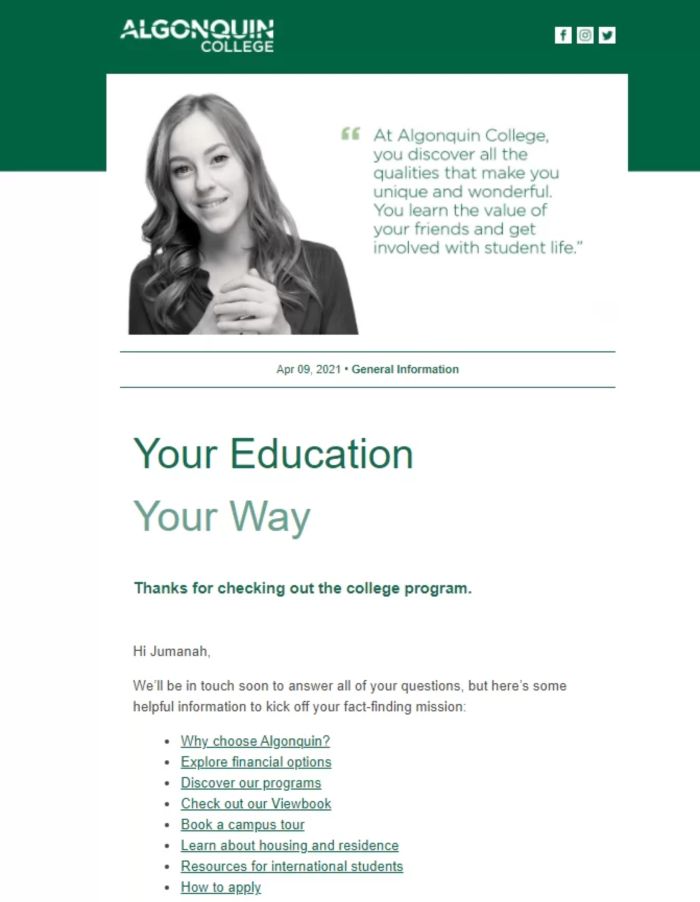

Source: Algonquin College
Consideration
Now that they’re paying attention, it’s time to educate. Share program benefits, tuition details, and testimonials. Even better, offer personalized interaction, like a Q&A session with advisors. Emails at this stage become your student’s research partner.
Example: Miami Ad School implemented a direct and informative follow-up email targeting prospective students who had expressed prior interest in one of its portfolio programs. The message used light personalization and concise formatting to clearly lay out the next steps for engagement. This email served as an early-stage consideration touchpoint designed to convert inquiry-stage leads into applicants.
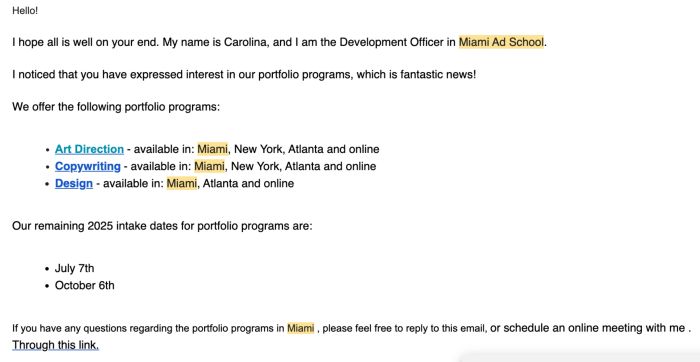

Source: Miami Ad School
Decision
Here’s where the magic happens, or it doesn’t. Use emails to overcome last-minute doubts, emphasize application deadlines, and make it ridiculously easy to act. Offer a call with an advisor. Include direct application links. This is where you close the loop.
Enrollment
Don’t stop now. Once students say “yes,” keep the momentum going. Celebrate with a warm welcome, then guide them through the next steps: registration links, orientation videos, and community invites. Make them feel like part of something exciting.
The Anatomy of a Winning Email
So what does a high-converting email actually look like?
1. Craft Irresistible Subject Lines
- Include first names or program names
- Add urgency (“Last Chance!”) or exclusivity (“Just for You”)
- Steer clear of spammy ALL CAPS and excessive punctuation
Example:
[Alex], Your Journey to an International Career Starts Here
2. Write Compelling CTAs
- Be specific and action-driven:
- “Apply Now”
- “Book a Call”
- “Join the Webinar”
- Explore more about email CTA best practices
3. Optimize for Timing and Mobile
- Test send times (mid-week often work well)
- Mobile-first design is a must; 55% of emails are opened on phones
- Responsive layouts = higher clicks and happier readers
Stay Out of Spam and In Their Good Books
Even the best content won’t help if it lands in the junk folder. Avoid spam triggers (like “FREE!!!”). Keep your database clean, and follow laws like CAN-SPAM (US), CASL (Canada), and PECR (UK). And yes, always include that unsubscribe link; it builds trust.
Fun fact: The average inbox placement rate is 83%, so there’s room to optimize.
Build Relationships With Drip Campaigns
Think of a drip campaign as a well-timed sequence of nudges. It starts with a thank-you or auto-response after form submission.
Then, over days or weeks, you send emails that deepen interest, event invites, alumni success stories, or a reminder to complete an application. Every email has a purpose. Every message moves the needle.
Track What Really Matters
If you’re only looking at open rates, you’re missing the bigger picture.
Here’s a smarter approach:
- Use open rates to gauge subject line effectiveness (aim for 46–50%)
- Analyze click-through rates to measure engagement, event invites can hit 15–25%
- Most importantly, track conversion rates: Are students applying, booking meetings, or showing up?
The data doesn’t lie. HEM’s insights show that most student bookings happen only after a lead is nurtured, sometimes weeks after their first touchpoint.
Final Thoughts: Your Enrollment Power Tool
We’ve covered a lot of ground, and you might be thinking, “How do I implement all of this?” The key is to view these strategies not as isolated tactics, but as complementary pieces of a holistic email marketing plan.
Segmentation gives you the framework (who gets what), personalization adds the special sauce (making content relevant to each individual), drip campaigns provide the delivery engine (timing and automation), mobile optimization ensures your efforts actually get seen on students’ preferred devices, and enrollment-stage alignment keeps your messaging strategy coherent from start to finish.
Each strategy is powerful on its own, but together they truly transform your email marketing from a simple broadcast tool into an engaging, research-backed recruitment machine.
You’ll be speaking to the right student with the right message at the right time – and that’s a recipe for higher open rates, click-throughs, and conversion to applications and enrollments. Just ask the institutions we discussed: they’ve seen application surges, increased yield, and record enrollments by putting these principles into practice.
To recap, how can colleges increase enrollment? Colleges can boost enrollment by improving lead nurturing (e.g., drip email campaigns), enhancing website conversion, offering personalized communication, streamlining the application process, and using data to better target and engage prospective students.
Done right, email isn’t just part of your marketing mix. It’s the glue that holds your enrollment strategy together.
Frequently Asked Questions
Question: What is educational marketing?
Answer: Educational marketing refers to the strategies and tactics used by schools, colleges, and universities to attract, engage, and enroll students. It includes campaigns across digital channels like email, social media, SEO, and paid ads to promote programs and build institutional brand awareness.
Question: How do you develop a marketing strategy for a university?
Answer: Start by defining clear goals (e.g., increase applications or improve yield), identify target audiences using personas, choose the right channels (email, social, SEO), create tailored content for each stage of the student journey, and measure results regularly to optimize performance.
Question: How can colleges increase enrollment?
Answer: Colleges can boost enrollment by improving lead nurturing (e.g., drip email campaigns), enhancing website conversion, offering personalized communication, streamlining the application process, and using data to better target and engage prospective students.





